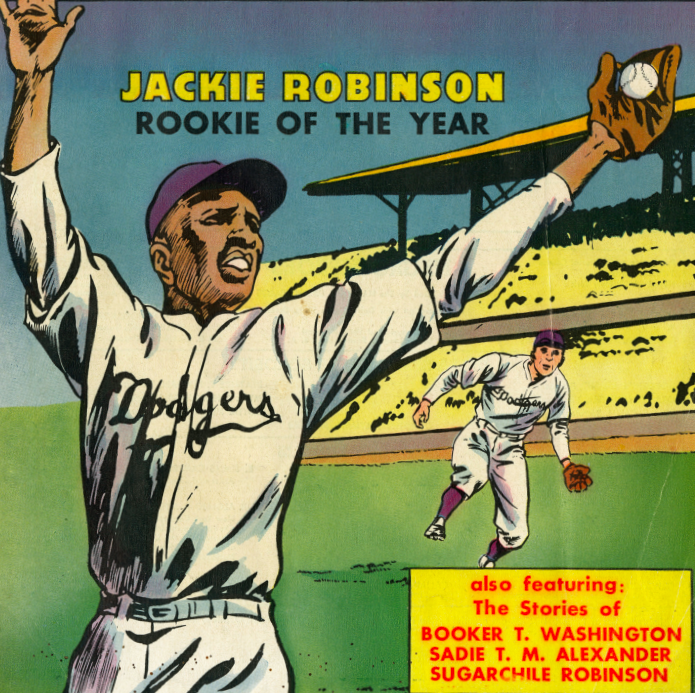Explore Black History Month Resources
Posted by Gilder Lehrman Staff on Tuesday, 02/06/2024
In celebration of Black History Month, the Gilder Lehrman Institute highlights resources for studying Black history in America through curated groupings of documents and accompanying materials.
Frederick Douglass Resources
 The Gilder Lehrman Institute is fortunate to have several original Frederick Douglass documents in the Gilder Lehrman Collection and has amassed many scholarly responses to the life and work of the escaped enslaved man turned abolitionist leader.
The Gilder Lehrman Institute is fortunate to have several original Frederick Douglass documents in the Gilder Lehrman Collection and has amassed many scholarly responses to the life and work of the escaped enslaved man turned abolitionist leader.
See this Frederick Douglass Resources page for letters written by Douglass, including one to his former owner; essays; and an online exhibition about Frederick Douglass’s journey to New York City.
In the Institute’s video collection, Yale professor and author of 2018’s Frederick Douglass: Prophet of Freedom, David Blight, discusses Frederick Douglass and Abraham Lincoln and the Importance of Frederick Douglass, while Dickinson College professor and Lincoln scholar Matthew Pinsker explores Frederick Douglass’s Reconstruction Era statements about President Lincoln.
 Frederick Douglass Traveling Exhibition
Frederick Douglass Traveling Exhibition
Frederick Douglass: Advocate for Equality
Frederick Douglass: Advocate for Equality features an exploration of the full trajectory of Douglass’s epic life from 1818 to 1895. In this six-panel traveling exhibition, viewers can learn about Douglass’s escape from slavery, his work as an abolitionist, and his tireless fight for full equality for all individuals into the Jim Crow era.
This exhibition was created for high school and adult audiences but can be adapted for younger audiences with targeted programming and historical context. Exhibitions are available for sale or rent, for shared, rotating use, or permanent installation.
Inside the Vault
 Inside the Vault: Highlights from the Gilder Lehrman Collection is an online program that highlights unique primary sources from the Gilder Lehrman Collection. Episodes have featured significant figures, movements, and events in Black History.
Inside the Vault: Highlights from the Gilder Lehrman Collection is an online program that highlights unique primary sources from the Gilder Lehrman Collection. Episodes have featured significant figures, movements, and events in Black History.
- Inside the Vault: Black Patriots in the American Revolution - featuring documents that recorded the service of Black soldiers in the Continental Army and reveal their postwar experiences
- Inside the Vault: Fighting for the Rights of Black Lives in the Founding Era - We examine the writings of Piece Hall and James Forten, two men who fought for the rights of Black lives in the Founding Era.
- Inside the Vault: The Lives and Works of Phillis Wheatley and Elizabeth Keckley featuring Wheatley’s Poems on Various Subjects, Religious and Moral and Keckley’s Behind the Scenes, or Thirty Years a Slave, and Four Years in the White House
- Inside the Vault: Civil War Diaries of William Woodlin, 8th USCT, & Cyrena Hammond - An exploration of the diaries of 22-year-old William Woodlin, a musician in the 8th United States Colored Troops, and 18-year-old Cyrena Hammond, from Clarendon, New York.
- Inside the Vault: Jackie Robinson - Letters from Dwight Eisenhower, John F. Kennedy, Robert Kennedy, and Richard Nixon to Jackie Robinson about his civil rights work inspire this episode about sports and civil rights legend Jackie Robinson.
- Inside the Vault: "Your future rests… in your hands!” - A 1964 comic book focusing on institutional segregation in employment, housing, education, and the importance of voting produced by the NAACP is the focus of this episode.
- Inside the Vault: The March on Washington - materials related to the organization of the March on Washington as well as the subsequent press coverage, including a report by the NAACP.
Black Lives in the Founding Era
 A vast offering of varied resources, the “Black Lives in the Founding Era” project restores to view the lives and works of a wide array of African Americans in the period 1760 to 1800. Drawing on our archive of historical documents and network of scholars and master teachers, the Institute has produced digital and print materials and offers a variety of programs throughout this year and beyond.
A vast offering of varied resources, the “Black Lives in the Founding Era” project restores to view the lives and works of a wide array of African Americans in the period 1760 to 1800. Drawing on our archive of historical documents and network of scholars and master teachers, the Institute has produced digital and print materials and offers a variety of programs throughout this year and beyond.
Begin or continue exploring this rich and important history here.
History U Courses
 History U offers free, self-paced courses in American history to high school students led by the nation’s top historians. Courses most relevant to studying Black history include
History U offers free, self-paced courses in American history to high school students led by the nation’s top historians. Courses most relevant to studying Black history include
- Black Women’s History, taught by Wellesley College professor Kellie Carter Jackson
- The History of American Protest, taught by Harvard University professor John Stauffer
- The Life and Writings of Frederick Douglass, taught by Yale University professor David Blight
- Race and Rights in America, taught by Washington and Lee University professor Lucas Morel
- The Revolutionary Lives of Malcolm X and Martin Luther King Jr., taught by University of Texas at Austin professor Peniel Joseph
Also explore Self-Paced Courses relating to African American history:
- African American History since Emancipation, taught by University of Texas at Austin professor Peniel Joseph
- Black Lives in the Founding Era, taught by Barnard College professor James G. Basker
- Black Women's History, taught by Wellesley College professor Kellie Carter Jackson
- Black Writers in American History, taught by Harvard University professor John Stauffer
- Lives of the Enslaved, taught by University of Texas at Austin professor Daina Ramey Berry
- Race and Rights in America, taught by Washington and Lee University professor Lucas Morel
- The Revolutionary Lives of Malcolm X and Martin Luther King Jr., taught by University of Texas at Austin professor Peniel Joseph
 BOOK BREAKS
BOOK BREAKS
Explore Our Book Breaks archive for conversations with authors about a wide variety of Black history topics, all free to teachers registered in our Affiliate Schools Program or anyone with a subscription:
- Daina Ramey Berry and Kali Nicole Gross - A Black Women’s History of the United States
- Keisha N. Blain - Until I Am Free: Fannie Lou Hamer's Enduring Message to America
- Lonnie Bunch - A Fool’s Errand: Creating the National Museum of African American History and Culture in the Age of Bush, Obama, and Trump
- Kellie Carter Jackson - Force and Freedom: Black Abolitionists and the Politics of Violence
- Marcia Chatelain - Franchise: The Golden Arches in Black America
- Matthew F. Delmont - Half American: The Epic Story of African Americans Fighting World War II at Home and Abroad
- Jonathan Eig - King, A Life
- Annette Gordon-Reed - The Hemingses of Monticello: An American Family
- Peniel Joseph - The Sword and the Shield: The Revolutionary Lives of Malcolm X and Martin Luther King Jr.
- Kostya Kennedy - True: The Four Seasons of Jackie Robinson
- Tamara Payne - The Dead Are Arising: The Life of Malcolm X
- Alaina E. Roberts - I’ve Been Here All the While: Black Freedom on Native Land
- Theresa Runstedtler - Black Ball: Kareem Abdul-Jabbar, Spencer Haywood, and the Generation That Saved the Soul of the NBA
- Clint Smith - How the Word Is Passed: A Reckoning with the History of Slavery across America
- Jeanne Theoharis - The Rebellious Life of Mrs. Rosa Parks
- Mark Whitaker - Saying It Loud: 1966–The Year Black Power Challenged the Civil Rights Movement
Hamilton Cast Read Alongs
 Hamilton Cast Read Alongs is a program that features Hamilton cast members reading award-winning children’s books followed by a discussion of the history behind the story led by Gilder Lehrman Master Teacher Keisha Rembert. Enjoy these featured recordings relating to Black history:
Hamilton Cast Read Alongs is a program that features Hamilton cast members reading award-winning children’s books followed by a discussion of the history behind the story led by Gilder Lehrman Master Teacher Keisha Rembert. Enjoy these featured recordings relating to Black history:
- Before She Was Harriet - Read by Marja Harmon (Angelica Schuyler Church in the North American tour of Hamilton). Written by Lesa Cline-Ransome and illustrated by James E. Ransome.
- The Escape of Robert Smalls: A Daring Voyage Out of Slavery - Read by Christopher Jackson (George Washington in the Original Broadway Cast of Hamilton). Written by Jehan Jones-Radgowski and illustrated by Poppy Kang. Special introduction by Senator Cory Booker of New Jersey.
- Exquisite: The Poetry and Life of Gwendolyn Brooks - Read by Krystal Joy Brown (Eliza Schuyler Hamilton in Hamilton on Broadway). Written by Suzanne Slade and illustrated by Cozbi A. Cabrera.
- Goin’ Someplace Special - Read by Morgan Wood (Ensemble in the North American Tour of Hamilton). Written by Patricia C. McKissack and illustrated by Jerry Pinkney.
- Harlem’s Little Blackbird: The Story of Florence Mills - Read by Renée Elise Goldsberry (Angelica Schuyler in the Original Broadway Cast of Hamilton). Written by Renée Watson and illustrated by Christian Robinson.
- Ticktock Banneker’s Clock - Read by Ashley Brooks Monroe (Resident Director for the North American tour of Hamilton). Written by Shana Keller and illustrated by David C. Gardner
More Resources and Lesson Plans
The 54th Massachusetts Regiment in the Gilder Lehrman Collection
The Gilder Lehrman Collection holds letters, diaries, and works of art dedicated to “The Fighting 54th” Regiment from Massachusetts. Composed of volunteers, the 54th was the first African American regiment organized by the Union Army during the American Civil War. It is perhaps best known for leading the charge on Fort Wagner in Charleston Harbor, South Carolina, on July 18, 1863. The regiment suffered devastating losses, but its bravery became a rallying point for the Union Army and inspiration in the recruitment of African American soldiers. The 54th Regiment, which fought on through 1865, inspired many monuments, paintings, and, in 1989, a favorite film of American history teachers and students everywhere, Glory.
Explore this legendary chapter of Black history here.
Plessy v. Ferguson and Brown v. Board of Education
We highlight our resources on the original 1896 case and its overturning with the 1954 Brown v. Board of Education decision.
- A video in which Larry Kramer, former dean of Stanford Law School, delves into the details of Brown v. Board of Education and examines the effect it had on the Civil Rights Movement at large
- A full collection of resources across GLI